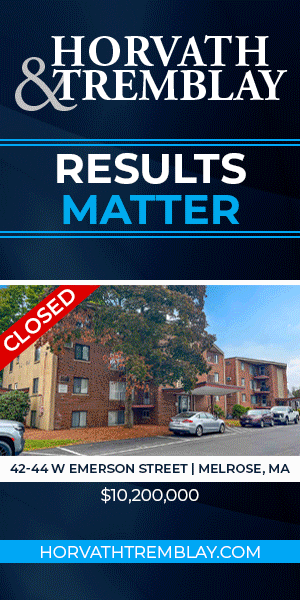When The Ink Dries; The Recycling of Newspaper Headquarters
May 02, 2019 - By Jim Morrison
BOSTON–The newspaper business has undergone tremendous upheaval over the last 15 years. Most companies have struggled to survive in the digital news age. Gone are the days of the major big-box retailers jockeying, and paying heavily, for the first fifteen consecutive-page ad positions. According to the Bureau of Labor Statistics, more than half of the newspaper jobs that existed in 2001 are gone. In 2016, the newspaper industry’s ad revenue was nearly a third of what it was a decade before, falling to $18 billion from $49 billion, according to Pew Research Center. Even Warren Buffet, the billionaire chief executive officer of Berkshire Hathaway Inc. recently admitted in an interview with Yahoo Finance that, “most newspapers are toast.”
Many newspaper companies have had to sell their buildings to stay alive, while others have found themselves owning or leasing more space than they need - and that has created some interesting commercial development opportunities for visionary investors. We took a look at some of the largest newspapers in the region to see what has happened to their buildings - after the ink has dried.
The Boston Globe
In 2013, billionaire Red Sox owner, John Henry bought New England’s largest newspaper, the Boston Globe- for $70 million. In 2017, he moved the paper back to its downtown roots at 53 State Street. That same year, Henry sold the paper’s former iconic headquarters - a 6.6 acre-site at 135 Morrissey Boulevard, in Dorchester to Nordblom Company and Alcion Ventures, for $81 million.
Nordblom is currently undergoing major construction renovations to the property as they begin to transform the asset into a mixed-use campus which they predict could add as many as 3,000 jobs to the Boston economy.
The project, dubbed The BEAT, is well underway with lofty expectations to be completed by the end of 2019. The sprawling structure will feature 360,000 square-feet of office space and 300,000 square-feet of flex/light industrial, along with retail space, a fitness center, a restaurant, and an outdoor beer garden. The commercial space will be designed to attract businesses in the robotics, life sciences, high-tech manufacturing, and other similar technology fields. The site is a five-minute walk from the JFK/UMass stop on the red line and will feature 868 parking spaces as well as bicycle storage for 200.
The Globe moved its four-story printing plant from the former Dorchester headquarters site in 2017 to a new $20.3 million facility in the Miles Standish Office Park in Taunton.
The Boston Herald
In 2007, Pat Purcell, owner of The Boston Herald, sold the paper’s 6.6-acre headquarters at 275 Albany Street in the South End to National Development for an undisclosed amount. That site (combined with adjacent properties National Development acquired) is now the home of a successful development called Ink Block - a mixed-use neighborhood of approximately 400 high-end apartments and condos, a 50,000 square foot Whole Foods supermarket and many smaller retail shops, restaurants and gyms as well as a six-story hotel.
In 2011, the Herald newspaper company moved to the South Boston Seaport. After filing for bankruptcy in 2017, the paper was acquired by Digital First Media for just under $12 million.
In 2018, the Herald left its South End headquarters and moved their operations to 70 Fargo Street in the Seaport. At the time, the paper was printed by the Boston Globe in Dorchester and moved with that paper’s printing operations to the Taunton facility, but after several months of printing and delivery problems, the Herald hired the Providence Journal to print the hard-copy edition. In 2018, the Herald left the city altogether and moved to a Braintree office park at 100 Grossman Drive.
The Worcester Telegram & Gazette
When it was owned by the Boston Globe, the Worcester T&G was printed at 9 Latti Farm Road until 2012, when the Globe sold that building to Anthony F. Russell for $5.6 million. The newspaper company is now owned by Gatehouse Media and is printed in Auburn, Massachusetts.
Still searching for tenants, the 38-acre Latti Farm Road has yet to be repurposed. Will Kelleher IV of Kelleher & Sadowsky, who represented the property when it sold, said he has shown it approximately 100 times. He said because of the size and location there is still a fair amount of interest in the property.
“It’s adjacent to the Mass Turnpike and Route 146,” Kelleher said. “Given the ceiling height, it might be good for some light manufacturing or as a warehouse. The land isn’t all buildable, but might be good for parking trailers. It’s an unusual mix of office space and a high-bay press room.”
The Providence Journal
The Providence Journal, the largest Rhode Island daily newspaper and the oldest continuously published daily in the country, bought its current headquarters in 1934. In 2015, the Journal sold the headquarters at 75 Fountain St. to developers Nordblom (developers of previously mentioned The Beat) and Providence-based, Cornish Associates for $3,315,000. Nordblom and Cornish renovated the building, resulting in 160,000 square feet of office space and 10,000 square feet of retail space. The paper currently leases office space on the second floor of the building along with neighbors Tufts Health, Virgin Pulse and Infosys.
The Phoenix/Massweb
Will Kelleher said the Boston Phoenix and several other alternative newspapers were once printed by Massweb Printing at 314 Washington St., Auburn, as his firm brokered that sale as well.
“The issue with that [building] sale was that the printing industry was messy with inks and machinery … it was difficult to show. That building was in rough shape, but it was in a good location and it was repurposed as a gym. The owners renovated, added parking, and made it into Impact Fitness Club, confirms Kelleher.”
The Concord Monitor
Deane Navaroli of William & Reeves Commercial Real Estate listed 1 Monitor Dr. Concord, NH, home of the Concord Monitor, for sale in February of 2019. The building is 77,000 square feet on 103 acres, listed for $6.5 million.
According to an article in the Monitor, the company is going to move its printing function to a former manufacturing building in Penacook, NH, in the north part of Concord. The newsroom will move closer to downtown Concord.
“If you look at it as two buildings, it could be something like a corporate insurance company or some other corporate office,” Navaroli said. “The trick will be readapting the manufacturing portion; that could be high-tech assembly space, r&d, or manufacturing. In some ways, it could be an exceptional charter school, university or trade school. It could also be a multi-tenant office space or even a machine shop or a [tech] training center.”
If there’s enough interest, Navaroli said, all or part of that land could even be developed for residential housing. “Some groups are interested in developing the land,” he said. “The city is very interested in seeing it developed. It’s not zoned for residential, it’s zoned industrial, but given the level of interest the city has, it could be rezoned. The land is right on the Merrimack River.”
The New Hampshire Union Leader
Built in 1990 and expanded in 2003, The New Hampshire Union Leader building at 100 William Loeb Drive in Manchester, NH sold in Sept 2017. The paper is still occupying some of the space, and leasing some to charter schools. According to an online listing, there is available open space for lease ranging between 5,000-105,000 square feet on the 20.44-acre site. The modern structure is within a few minutes drive from Interstate 93.
“Newspaper buildings are unique, but with a little creativity, they can be adaptively repurposed,” Navaroli assesses of the Union leader building.
Transitioning to digital media, given the on-demand pull of news via mobile devices has all but replaced the wood pulp sheets, printed from expensive presses, using expensive ink and deployed via expensive vehicles. Accordingly, it should be no surprise when we read (digitally) that newspapers will discontinue their hard-copy publications and shut down printing headquarters. In turn, optimistically, the massive media shift will continue to present great opportunities for developers to reimagine and repurpose properties within historical buildings at optimal locations.
 Interior Rendering of The Beat
Interior Rendering of The Beat
 Ink Block, Boston MA
Ink Block, Boston MA
 9 Latti Farm Road, Worcester MA
9 Latti Farm Road, Worcester MA
 75 Fountain Street Providence RI
75 Fountain Street Providence RI
 314 Washington Street, Aubrn, MA
314 Washington Street, Aubrn, MA
 1 Monitor Dr. Concord, NH
1 Monitor Dr. Concord, NH
 100 William Loeb Dr. Manchester NH
100 William Loeb Dr. Manchester NH

.gif?mtime=1757534141)



